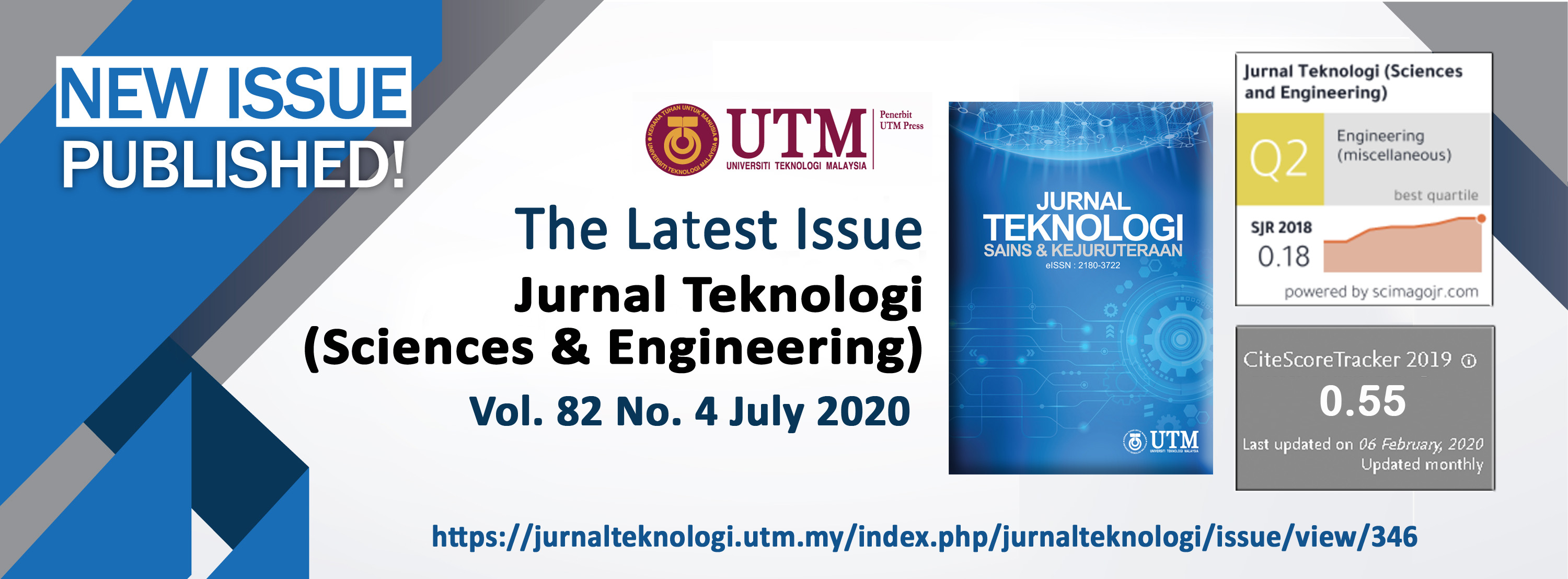COMBUSTION STUDY OF WASTE COOKING OIL BIODIESEL IN AN OIL BURNER
DOI:
https://doi.org/10.11113/jt.v82.13908Keywords:
Transesterification, waste cooking oil, oil burner, emission, NOxAbstract
Depletion of fossil fuels, concerns on environment, and fuel price fluctuation have become the major drives in searching for sustainable alternative fuel. In that regard, a study was conducted to evaluate the combustion performance of Waste Cooking Oil (WCO) converted into biodiesel and blended with Conventional Diesel Fuel (CDF) as a mean of sustainable replacement for diesel fuel. In this study, the production of biodiesel fuel from waste cooking oil was done via transesterification process, using the single step approach. The properties of the WCO biodiesel was characterized. The combustion performance of the produced fuels has been studied for B10 and B30 biodiesel from WCO and CDF (as baseline) based on their wall temperature profiles and gaseous emissions generated such as nitrogen oxides (NOx), carbon monoxide (CO) and sulphur dioxide (SO2). It was found that the B30 WCO biodiesel emits lower emission compared to CDF but at the same time generates a lower temperature profile.
References
Shirneshan, A. 2013. HC, CO, CO2 and NOx Emission Evaluation of a Diesel Engine Fueled with Waste Frying Oil Methyl Ester. Energy Procedia. 75: 292-297.
Issariyakul, T., Dalai, A. K. 2014. Biodiesel from Vegetable Oils. Renewable and Sustainable Energy Reviews. 31(3): 446-471.
Huang, D., Zhou, H., Lin, L. 2012. Biodiesel: An Alternative to Conventional Fuel. Energy Procedia. 16: 1874-1885.
Abdul Raqeeb M. 2015. Biodiesel Production from Waste Cooking Oil. Journal of Chemical and Pharmaceutical Research. 7(12): 670-681.
Yasin, M. H. M., Mamat, R., Yusop, A. F. et al. 2013. Fuel Physical Characteristics of Biodiesel Blend Fuels with Alcohol as Additives. Energy Procedia. 53: 701-706.
Attia, A. M. A., Hassaneen, A. E. 2015. Influence of Diesel Fuel Blended with Biodiesel Produced from Waste Cooking Oil on Diesel Engine Performance. Fuel. 167: 316-328.
Verma, P. and M. Sharma. 2016. Review of Process Parameters for Biodiesel Production from Different Feedstocks. Renewable and Sustainable Energy Reviews. 62: 1063-1071.
Ciolkosz D. 2015. What’s So Different about Biodiesel Fuel? Bioenergy. 551-555.
Campus P. 2011. Comparative Analysis of Fuel Characteristics of Bio-diesel Produced from Selected Oil-bearing Seeds in Nigeria. European Journal of Scientific Research. 58: 238-246.
Hwang, J., C. Bae, and T. Gupta. 2016. Application of Waste Cooking oil (WCO) Biodiesel in a Compression Ignition Engine. Fuel. 176: 20-31.
Rahim M. R. and M. N. M. Ja’afar. 2015. Kesan Sudut Pusaran Terhadap Pembakaran Menggunakan Pemusar Jejarian Dwi Aliran. Jurnal Teknologi. 77(8): 37-45.
Jha, S. K. and S. Fernando. 2007. Flame Temperature Analysis of Biodiesel Blends and Components. ASABE Annual International Meeting, Minneapolis, MN. June 17-20. Paper # 076234.
Lapuerta M., O. Armas, and J. Rodriguez-Fernandez. 2008. Effect of Biodiesel Fuels on Diesel Engine Emissions. Progress in Energy and Combustion Science. 34: 198-223.
Sawarimuthu S. and M. N. M. Ja’afar. 2008. Performance of Various Biofuel Blends on Burner System. Jurnal Mekanikal. 27: 69-77.
Lim Y. C. and H. K. Suh. 2016. Prediction of Biodiesel Combustion, co and NOx Emission Characteristics in Accordance with Equivalence Ratio. Journal of the Korean Society of Combustion. 21: 1-7.
Jaafar M. N. M. and S. Safiullah. 2018. Combustion Characteristics of Rice Bran Oil Biodiesel in an Oil Burner. Jurnal Teknologi. 80(3): 185-192.
Downloads
Published
Issue
Section
License
Copyright of articles that appear in Jurnal Teknologi belongs exclusively to Penerbit Universiti Teknologi Malaysia (Penerbit UTM Press). This copyright covers the rights to reproduce the article, including reprints, electronic reproductions, or any other reproductions of similar nature.
















